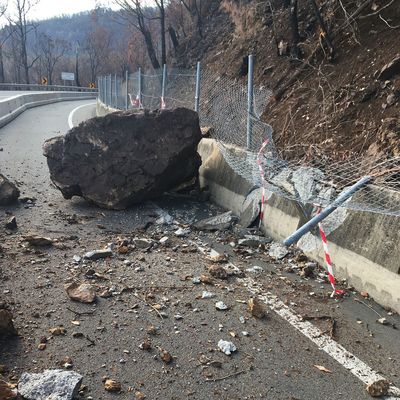
By Jeremy Sollars
The Department of Transport and Main Roads (TMR) says it has conducted “preliminary geotechnical and structural assessments” of the cliff face above the Cunningham Highway at Cunningham’s Gap after rock falls followed the recent bushfires.
The Gap was closed for lengthy periods in late 2019 due to bushfires and TMR has foreshadowed major works may be required to stabilise the cliff to prevent further rock falls.
The State Government conducted large-scale stabilisation works at a cost of nearly $60 million over a two-year period concluding in late 2012, after a series of highway closures from 2005 to 2010 due to land slips both above the highway and beneath it.
Those land slips were caused and hampered by heavy rain at various times leading to major engineering studies and a series of heavy works including the blasting out of a 23 tonne boulder in May 2010.
Concrete barriers and shipping containers on the western side of the highway through the Gap have since formed a line of defence against further land slips.
A boulder along with soil, rock and debris all weighing an estimated 20 tonnes fell to the base of the cliff in the first week of 2020, attributed by TMR to the recent bushfires.
A TMR spokesman this week said the assessments carried out as a result “identified long-term slope stability rectification works requiring complex design solutions, possible permanent road protection and restoration works”.
The State Government has previously looked at the options of a tunnel through the Main Range, a concrete structure over the highway and an alternative route through Spicers Gap as long-term options to ensure the reliability of the Cunningham Highway through the Gap.
The TMR spokesman this week said “safety mitigation measures” in the first week of 2020 “were activated at known high-risk areas enabling the highway to reopen, including a portable steel safety barrier inside the permanent concrete barrier”.
“Additionally, the speed limit was reduced to 50km/h and traffic controllers were on site for over a week continuing to monitor the situation,” the spokesman said.
“On-going inspections continue to be undertaken on-site.
“TMR is in the process of engaging geotechnical consultants to undertake detailed investigations of the area and to identify reconstruction requirements.
“Eligible reconstruction works are jointly funded by the Commonwealth and Queensland Governments under the Disaster Recovery Funding Arrangements (DRFA).”






